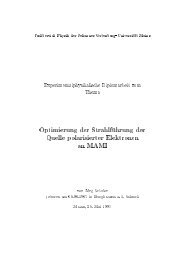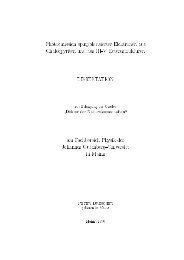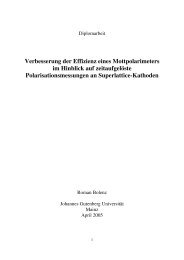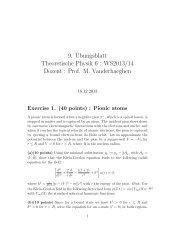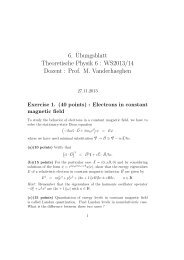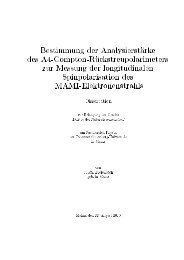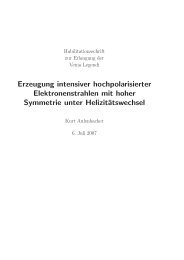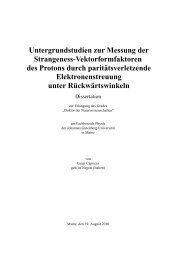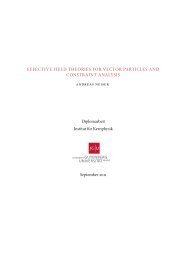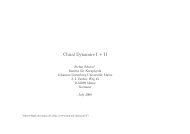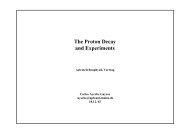Aufbau einer gepulsten Quelle polarisierter Elektronen - Institut für ...
Aufbau einer gepulsten Quelle polarisierter Elektronen - Institut für ...
Aufbau einer gepulsten Quelle polarisierter Elektronen - Institut für ...
Sie wollen auch ein ePaper? Erhöhen Sie die Reichweite Ihrer Titel.
YUMPU macht aus Druck-PDFs automatisch weboptimierte ePaper, die Google liebt.
Nuclear Instruments and Methods in Physics Research A 379 (1996) 15 – 20<br />
Picosecond polarized electron bunches from a strained layer<br />
GaAsP photocathode <br />
P. Hartmann a , J. Bermuth a , J. Hoffmann a , S. Köbis a , E. Reichert b1 , H. G. Andresen a1 ,<br />
K. Aulenbacher b1 , P. Drescher b1 , H. Euteneuer a1 , H. Fischer b1 , P. Jennewein a1 ,<br />
K.–H. Kaiser a1 , H. J. Kreidel a1 , Ch. Nachtigall b1 , S. Plützer b1 , M. Schemies b1 ,<br />
K.–H. Steffens a1 , M. Steigerwald b1 , H. Trautner b1 D. v. Harrach a2 , I. Altarev c2 ,<br />
R. Geiges a2 , K. Grimm a2 , Th. Hammel a2 , E. Heinen-Konschak a2 , H. Hofmann a2 ,<br />
E.-M. Kabuß a2 , A. Lopes-Ginja a2 , F. Maas a2 , E. Schilling a2<br />
a <strong>Institut</strong> für Kernphysik, Joh. Gutenberg - Universität, Mainz, Germany<br />
b <strong>Institut</strong> für Physik, Joh. Gutenberg - Universität, Mainz, Germany<br />
c St. Petersburg Nucl. Phys. Inst., RAS, 188350 St. Petersburg, Russia<br />
Received 19 April 1996<br />
Abstract<br />
At the Mainz electron accelerator MAMI a facility has been set up that allows the measurement of the bunchlength,<br />
the energy spread and the averaged and phase resolved polarization of picosecond electron bunches<br />
from a source of polarized electrons for MAMI. Electron bunches of typically 10 to 30 ps duration are generated<br />
by illuminating a strained layer GaAsP photocathode with femtosecond laser pulses.<br />
1. Introduction<br />
In recent years the demand on polarized electron beams<br />
for nuclear scattering experiments has constantly<br />
risen. Experiments at MAMI [1,2], CEBAF [3],<br />
SLAC [4] and many other sites either require tens of<br />
microamperes of average beam current or pulse currents<br />
of several amperes.<br />
The sources of polarized electrons used to satisfy these<br />
demands are usually based on the photoemission<br />
from III-V semiconductor photocathodes. Polarizations<br />
between 30 % and 50 % are achieved with simple<br />
bulk GaAs-type photocathodes [5]. Recently developed<br />
GaAs-type photocathodes, consisting of superlattice<br />
or strained layer heterostructures, have enhanced<br />
the polarization up to 80 % and more[6,7].<br />
One unsolved problem since the first use of GaAs<br />
photocathodes at an accelerator site, is the decrease<br />
of quantum efficiency with time when current is extracted.<br />
The quantum efficiency of these photocathodes shows<br />
a dependence on the produced charge, that is well<br />
described by an exponential behaviour. Experience<br />
at MAMI shows that the cathode lifetime decreases<br />
when beam current is increased [8].<br />
Currently, strained layer photocathodes are installed<br />
in the MAMI source of polarized electrons. The source<br />
emits a d.c. beam using a cw laser [8]. Since the accelerator<br />
is radiofrequency (rf) driven, the d.c. beam<br />
has to be chopped and prebunched before it is injected<br />
into the accelerator. The chopper-prebuncher system<br />
has a capture efficiency of 16% at best (see Fig. 1).<br />
Thus a major part of the polarized current is not accepted<br />
at the injection point,<br />
I<br />
I DC<br />
84% not accelerated<br />
408 ps DC current from source<br />
This work is part of the Ph.D. thesis of P. Hartmann.<br />
Corresponding author. Address: <strong>Institut</strong> für Kernphysik,<br />
Johannes Gutenberg, Universität Mainz, J. J. Becherweg 45,<br />
55099 Mainz, Germany. Tel.: +49 6131 39 5808, fax: +49 6131<br />
39 2964, e-mail: hartmannakph.uni-mainz.de.<br />
1 B2-Collaboration.<br />
2 A4-Collaboration.<br />
0<br />
65 ps<br />
16% accelerated<br />
Fig. 1. The transmission of the d.c. source current<br />
through the accelerator. At best 16% of the generated<br />
electrons reach the experiment.<br />
t<br />
0168-9002/96/$15.00 Copyright c 1996 Elsevier Science B.V. All rights reserved<br />
PII S0168-9002(96)00470-6



